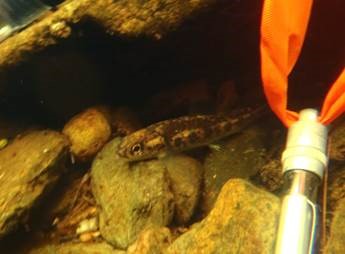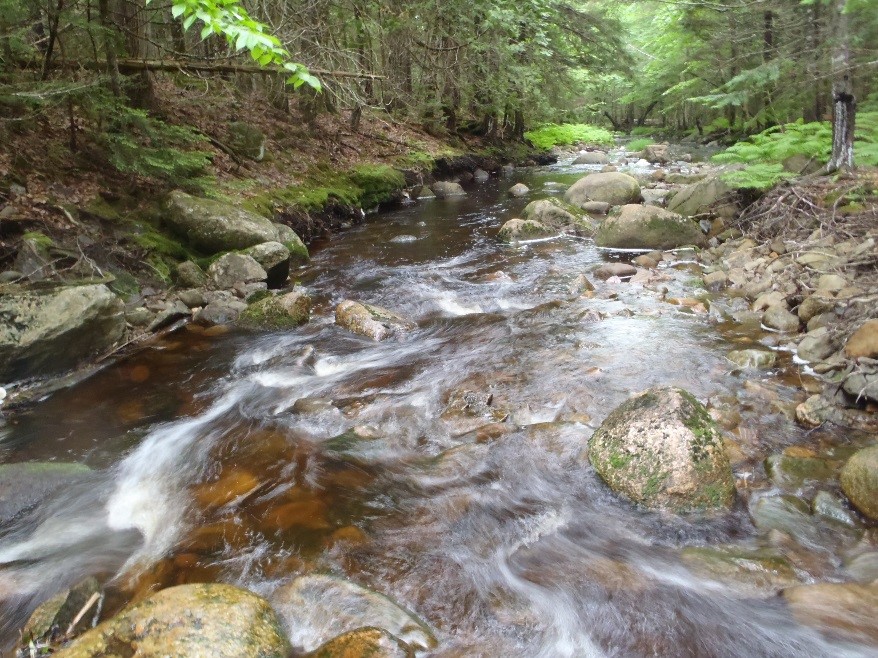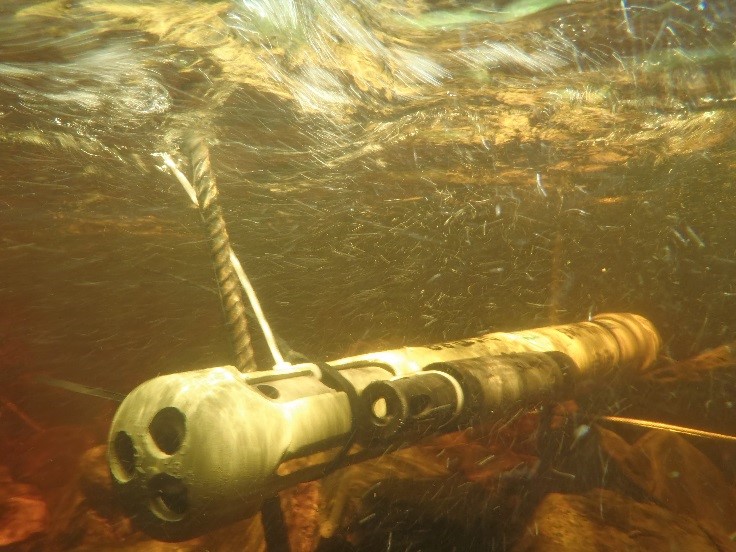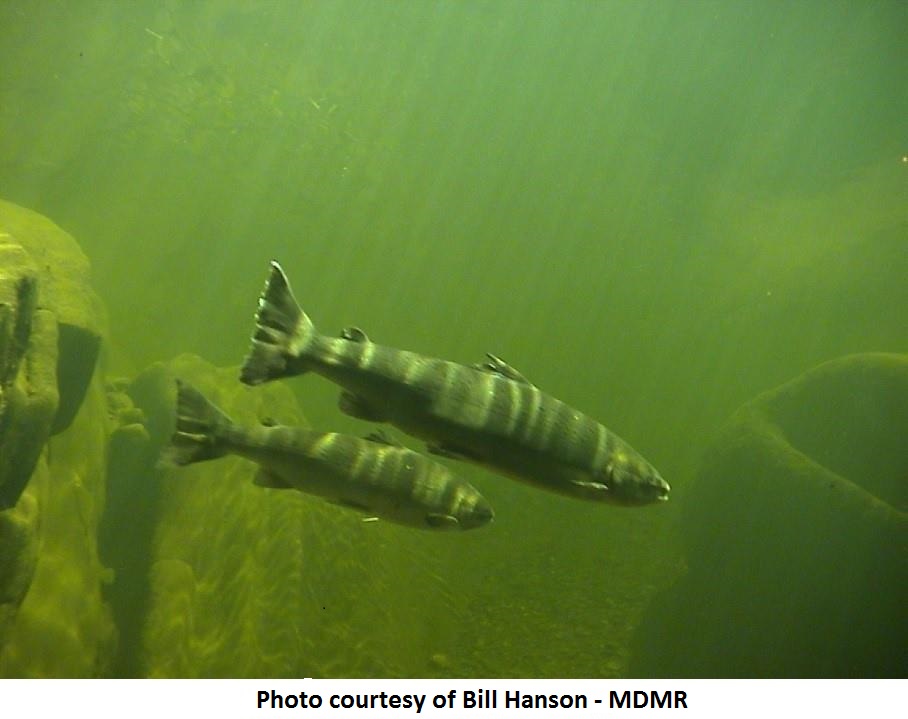Home → Water Quality → Monitoring → Rivers & Streams → Salmon Habitat Monitoring
Salmon Habitat Monitoring Program

Contacts:
- Emily Zimmermann 207-446-1003
- Net Pen Aquaculture:
- Permitting: Laura Crossley 207-615-6711
- Compliance: Holly Ireland 207-451-2286
Maine is home to the only remaining populations of wild Atlantic salmon (Salmo salar) in the United States. These constitute the Gulf of Maine Distinct Population Segment (DPS), which has been listed as endangered since 2000. As anadromous fish, salmon face a large suite of threats to survival in both fresh and saltwater environments, including dams, pollution, and (historically) overfishing. Climate change is also impacting salmon, as Maine’s climate is getting warmer and wetter (see the Scientific Assessment of Climate Change and Its Effects in Maine . Water quality is an essential component of suitable habitat for spawning and rearing. DEP monitors the water quality and biological communities in Maine's Atlantic salmon rivers and streams in close collaboration with state and federal agencies and non-profit groups, with the goal to restore and enhance the populations of this endangered species. Work is guided by Maine's water quality standards (38 M.R.S. Section 464 4-A; for further information see Maine's water classifications) and the Collaborative Management Strategy's Atlantic Salmon Recovery Plan.
Storm Frequency and Intensity
More intense storms are occurring more frequently, with more weather extremes. These storms can disrupt normal stream flows, eroding stream banks, washing out redds (‘nests’ of eggs) and flushing juvenile salmon from their protective rock or wood shelters. In addition, these high flows can threaten human infrastructure within the watershed. Maintaining connectivity between streams and their flood plains, including side channels, can help mitigate the impacts of intense storms, protecting both salmon habitat and human infrastructure. Replacing undersized culverts with Stream Smart crossings (i.e., bridges, arches, or large culverts) can provide enough capacity to pass extreme flows from storm events as well as sediment, debris, and fish to maintain natural stream function. Maintaining healthy riparian habitat, including diverse vegetation and large wood, can help stabilize stream banks.

Temperature and Low Flow Conditions
Maine’s warm season is getting longer, with temperatures predicted to rise 2-4°F by 2050 and 10°F by 2100 (see the Maine Climate Science Dashboard). Warming temperatures are occurring throughout the entire year. In the winter, warmer temperatures result in a lack of consistent ice cover, which allows harmful temperature fluctuations and ice formation on the stream bottom (also called frazil and anchor ice). In the summer, high temperatures often coincide with low flow conditions that can, in turn, result in an additional stress of low dissolved oxygen. Seasonal droughts exacerbate these sub-optimal conditions. Low flows may prevent movement of salmon to areas of refuge with cooler, oxygenated water, such as small tributaries or groundwater seeps. Undersized culverts and dams without adequate fish passage may exacerbate the problem by preventing salmon from accessing areas that could serve as refuge from summer temperatures.
Salmon exposed to sub-optimal conditions may experience sub-lethal physiological stress as well as increased likelihood of mortality due to predation. If recovery between stressful episodes is inadequate, or if conditions are extreme, the stream may not be habitable for Atlantic salmon. While cold-water native fish including Atlantic salmon, landlocked salmon, and brook trout are experiencing thermal stress, warm-water non-native fish such as smallmouth bass, largemouth bass, and northern pike are expanding their ranges, out-competing native fishes for resources and increasing predation. The protection of riparian zones, cold water tributaries, and in-stream refuges (such as log jams and deep pools) help increase the resiliency of the ecosystem to stressful temperature and flow conditions and is therefore important for the health of native fish populations. In addition, ensuring that fish can swim freely between different habitat types as temperatures rise is a key part of providing resilience in the face of a changing climate.
Acidification
The Clean Air Act has reduced the acidity of precipitation, however detrimental impacts due to acid rain are still predicted in areas with shallow soils, such as in Downeast Maine. Two centuries of logging in addition to acid rain have depleted the base cations from the system. The low buffering capacity of the underlying bedrock and surficial geology of the region result in greater impacts from acidification. Most waters in eastern Maine periodically experience acidic conditions (pH <6.5), resulting in detrimental impacts to salmon, especially during snow melt and spring/fall runoff. Liming acidic waters (using agricultural lime) has increased salmon abundance in Scandinavia and Nova Scotia and has been recommended as a restoration action for Maine. The addition of clam shells, a by-product of the local fishery, can improve water quality by increasing the buffering capacity of the treated area and allowing quicker recovery from stressful acidic periods (see reports below).

Reports
- Downeast Salmon Habitat Recovery Unit
- Acid mitigation and fisheries restoration in Eastern Maine:
- East Machias Watershed Study:
- Fourth Year of Clam Shells (PDF) (May 2023)
- Third Year of Clam Shells (PDF) (February 2022)
- Second year of Clam Shells (PDF) (April 2021; Video presentation, 22:47, March 2021)
- First year of Clam Shells (PDF) (February 2020)
- Baseline Summary Report (PDF) (March 2019)
- Baseline Data Report - Year 1 (PDF) (April 2018) and Summary - Year 1 (PDF) (April 2018)
- Pilot Study: Second Annual Report (PDF) (April 2012); Third Annual Report (PDF) (April 2013); Fourth Annual Report (PDF) (January 2014)
- East Machias Watershed Study:
- Water Chemistry of the Narraguagus River (PDF) (November 2008). Review of all available data.
- Merrymeeting Bay Salmon Habitat Recovery Unit
- Water Quality in Togus Stream (PDF) (January 2024)
- Temple Stream dam removal:
- Water Quality During a Small Dam Removal on Temple Stream (PDF) (April 2023)
- Water Quality in Temple Stream (PDF) (April 2022)
- Water Quality in Orbeton Stream (PDF) (April 2021)
- Penobscot Bay Salmon Habitat Recovery Unit
- Water Quality in Seboeis River (PDF) (February 2020)
- Water Quality in Wassataquoik Stream (PDF) (February 2019)
- Water Quality in the Upper East Branch Penobscot River (PDF) (September 2018)
- Impact of Katahdin Iron Works on Water Quality (PDF) (June 2010)
- Penjajawoc Stream Baseline Water Quality (PDF) (June 2010). Summary of first two years of volunteer monitoring.
Data and Maps
Salmon data are housed in DEP's central database, the Environmental and Geographic Analysis Database (EGAD). Salmon habitat is cataloged in the Maine Stream Habitat Viewer. Stream temperature data can be accessed in EcoSHEDS Northeast Stream Tempeature Database.
Further Information on Salmon
- State of Wild North Atlantic Salmon (NASCO)
- Salmon fact sheets (NOAA)
- Species in the Spotlight (NOAA)
- Salmon aquaculture (Maine Aquaculture Innovation Center)
